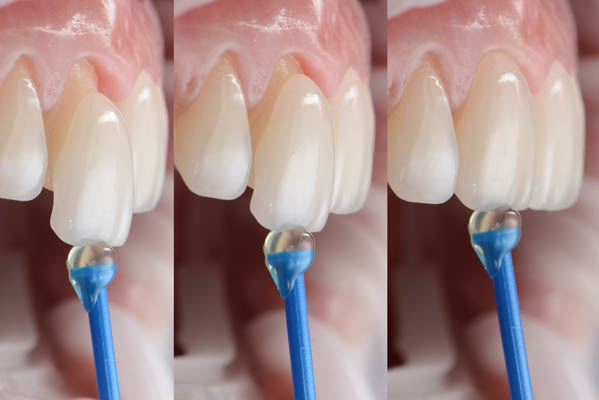Popular Dental Veneers Materials

Choosing veneers is a great idea for those who are in need of cosmetic dentistry in order to improve the look of their teeth. Veneers are custom-made for every patient and can change the size, shape and even length of a tooth. They can also cover up chips and stains and minimize any gaps between teeth.
How dental veneers are placed on teeth
Learning how veneers are placed is important, as placing veneers is a permanent cosmetic option. The reason it is a permanent option is that it is necessary to remove a small amount of a tooth’s enamel. This means that when a veneer begins to reach the end of its lifespan, it needs to be replaced with another veneer. The placement process requires one to make two dental appointments — one to get an impression of the teeth to be treated and another to have the veneers placed on the teeth.
Below is a list of the two materials dentists use to custom-make dental veneers for their patients.
Porcelain veneers
Porcelain dental veneers are made using very thin shells of porcelain. These thin shells are custom-made for every patient using an impression which is taken of their mouth. The impression is often sent to an outside dental laboratory to make the veneers and once they are made, they are sent to the dental office so a dentist can place them on the patient's teeth. The front surface of the teeth is first roughened up so the veneer can properly be cemented into place. The fact that the look of porcelain is very similar to the look of enamel makes porcelain veneers a popular veneer choice.
Porcelain pros include that they are natural-looking, stain-resistant and durable. Porcelain cons include that they may increase the sensitivity of teeth and it is possible to chip or break them.
Composite veneers
Composite dental veneers are applied to teeth using a special dental composite resin material. The process of applying composite veneers requires a dentist to first roughen up the front surface of the tooth so that the composite material will stay in place. Then they will carefully shape the composite material so that it improves the overall look of the tooth. Once the composite material has been molded to the tooth correctly, a special dental light is used to harden it. This light ensures that the composite material stays exactly where it is supposed to.
Composite pros include that it is a fast cosmetic option and allows a dentist to sculpt the material in a way that offers patients a natural-looking smile. Composite cons include that they have about half the lifespan of porcelain veneers.
Ready for dental veneers?
Now that the above information has been read, it is understood how dental veneers work to improve one’s smile. It is also understood that there are two popular materials used to create custom-made veneers: porcelain and composite. When it comes to choosing which material will better benefit someone, it is necessary to carefully consider the pros and cons of each material choice.
Are you considering getting veneers in the Plano area? Get more information at https://cissdental.com.
Check out what others are saying about our dental services on Yelp: Veneers in Plano, TX.
Recent Posts
Dental veneers are thin, custom shells that cover the front surfaces of teeth. These dental restorations are often made of porcelain. Many celebrities get dental veneers in order to achieve a stunning smile. Knowing more about these restorations can help you make informed decisions about your treatment. Here are the four main benefits of dental…
Dental veneers are ideal for those who wish to hide flaws on their smile. Imperfections and stains on the teeth can make people want to smile less. By placing veneers on the teeth, the imperfections are hidden and the smile can look its best. This article talks about how veneers work to make the smile…
Traditionally,dental restorations require an individual to have a physical impression of their mouth taken. Impressions are necessary to accurately create an indirect dental restoration, which are restoration made outside of the oral cavity and applied at a later time. Dental crowns, veneers, inlays and onlays are all examples of restorations that require impressions in order to…
Dental restoration procedures can be used to repair damaged teeth and restore their function. Many of these treatments also address aesthetic issues affecting the tooth. Teeth are one of the strongest parts of the body, but they also deal with many things that can damage them, like acids, bacteria and bite forces. Teeth can also…


